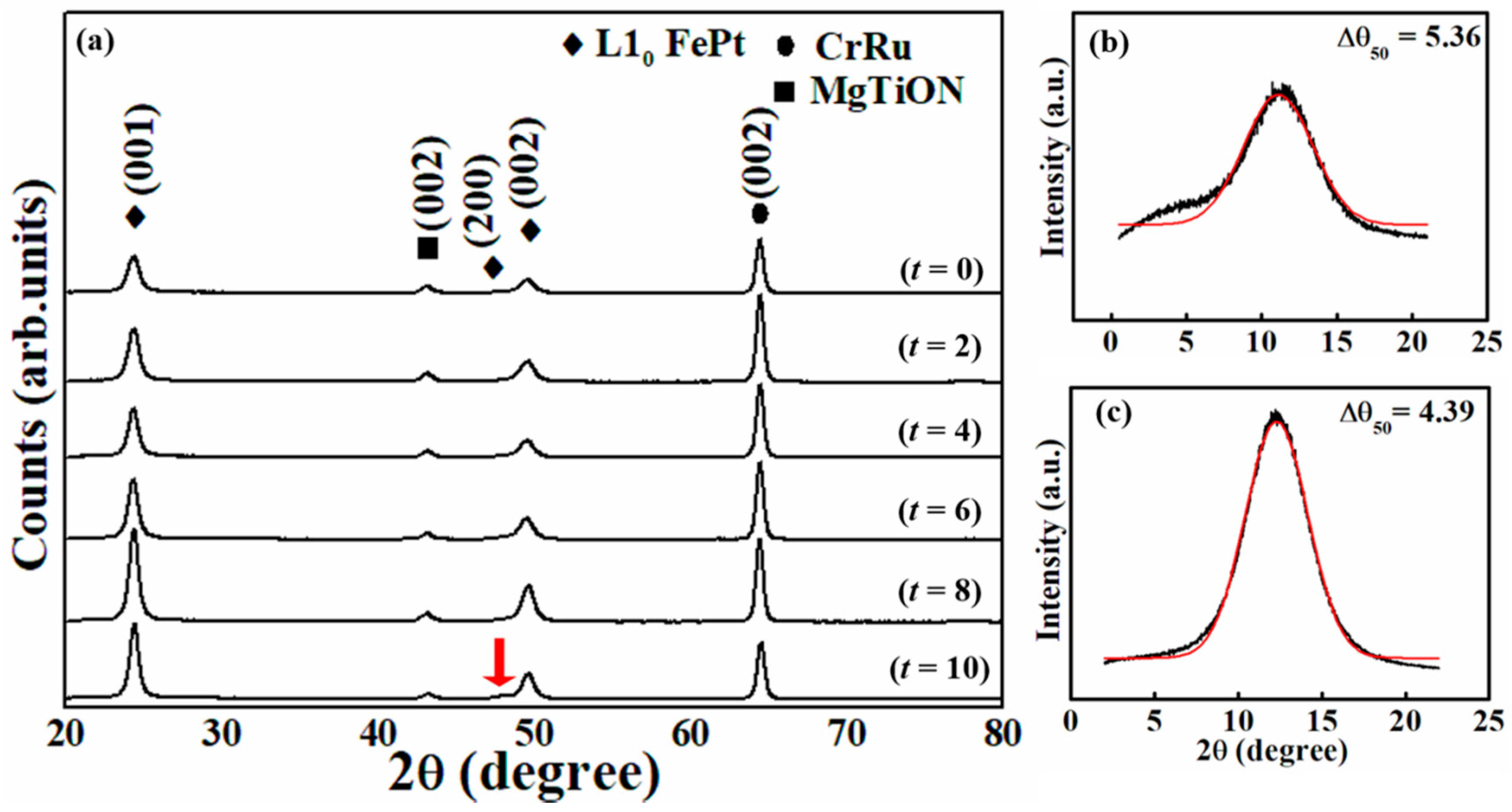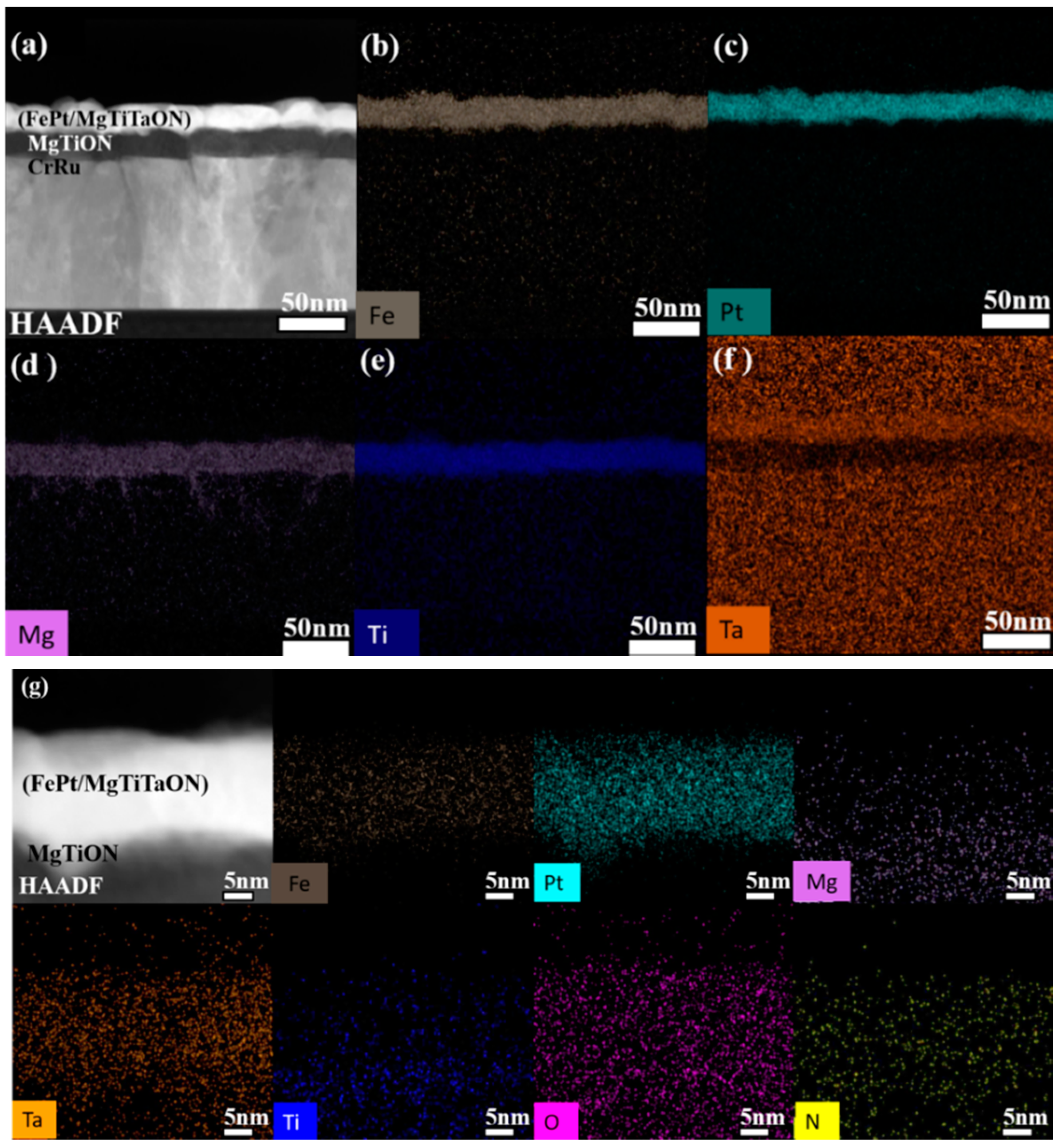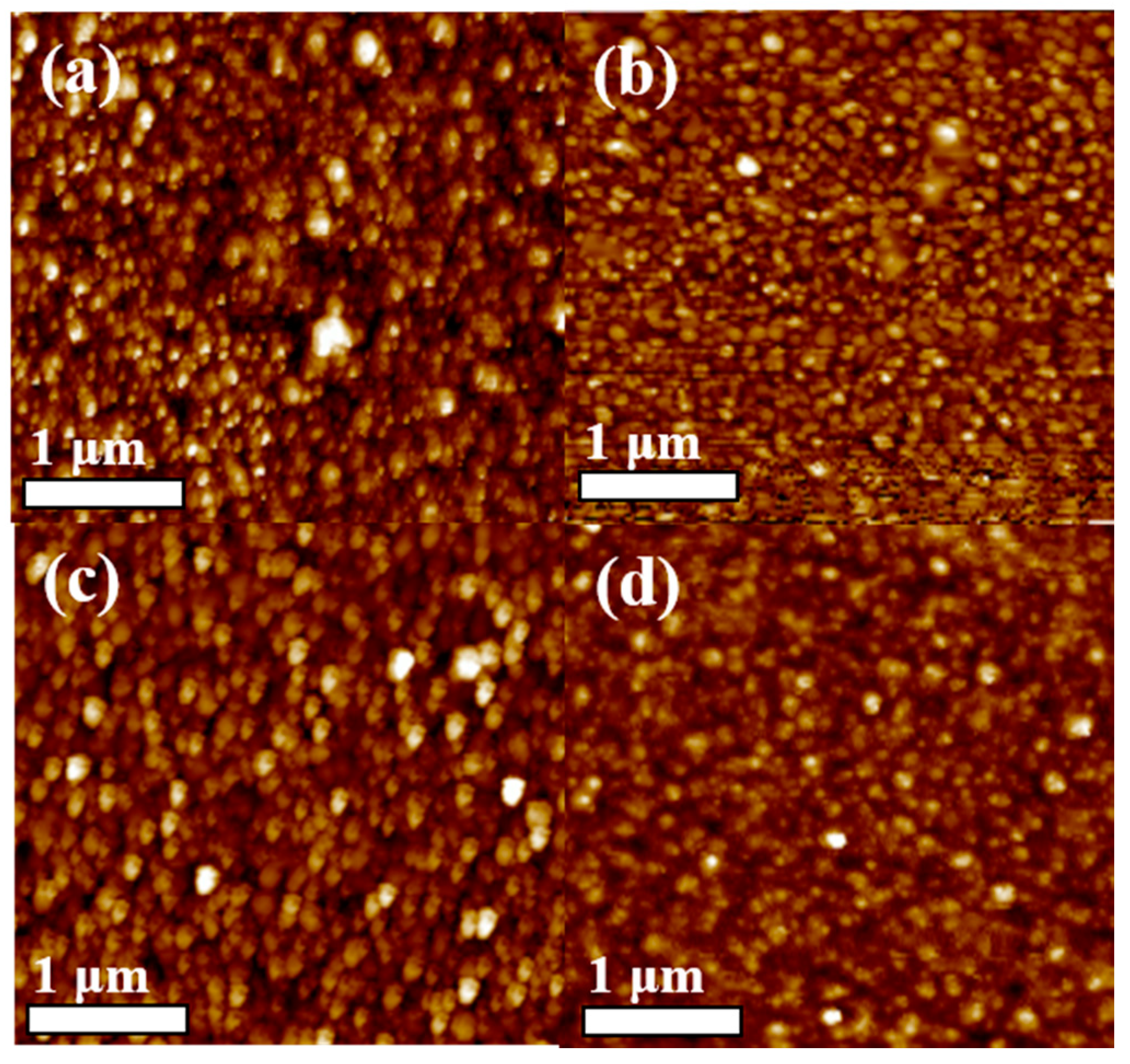Influence of an MgTiTaON Inserted Layer on Magnetic Properties and Microstructure of FePtAgC Films
Abstract
:1. Introduction
2. Materials and Methods
3. Results and Discussion
3.1. FePt(t nm)/[MgTiTaON(1 nm)/FePt(4 nm)]2/MgTiON/CrRu (t = 0, 2, 4, 6, 8, 10) Films
3.2. FePt(6 nm)(Ag,C)(x vol %)/[MgTiTaON(1 nm)/FePt(4 nm)(Ag,C)(x vol %)]2 (x = 0, 10, 20, 30, 40)
4. Conclusions
Author Contributions
Funding
Acknowledgments
Conflicts of Interest
References
- Hono, K.; Takahashi, Y.K. L10 FePt Granular Films for Heat-Assisted Magnetic Recording Media. In Ultrahigh Density Magnetic Recording; Varvaro, G., Casoli, F., Eds.; Pan Stanford Publishing: Singapore, 2016; pp. 246–277. [Google Scholar]
- Weller, D.; Parker, G.; Mosendz, O.; Lyberatos, A.; Mitin, D.; Safonova, N.Y.; Albrecht, M. Review Article: FePt heat assisted magnetic recording media. J. Vac. Sci. Technol. B 2016, 34, 060801. [Google Scholar] [CrossRef]
- Weller, D.; Mosendz, O.; Parker, G.; Pisana, S.; Santos, T.S. L10 FePtX–Y media for heat-assisted magnetic recording. Phys. Status Solidi A 2013, 210, 1245–1260. [Google Scholar] [CrossRef]
- Ju, G.P.; Peng, Y.G.; Chang, E.K.C.; Ding, Y.; Wu, A.Q.; Zhu, X.; Kubota, Y.; Klemmer, T.J.; Amini, H.; Gao, L.; et al. High density heat-assisted magnetic recording media and advanced characterization—Progress and challenges. IEEE. Trans. Magn. 2015, 51, 3201709. [Google Scholar] [CrossRef]
- Futamoto, M.; Ohtake, M. Development of media nanostructure for perpendicular magnetic recording. J. Magn. Soc. Jpn. 2017, 41, 108–126. [Google Scholar] [CrossRef]
- Zhang, L.; Takahashi, Y.K.; Perumal, A.; Hono, K. L10-orderedhighcoercivity(FePt)Ag–C granular thin films for perpendicular recording. J. Magn. Magn. Mater. 2010, 322, 2658–2664. [Google Scholar] [CrossRef]
- Shiroyama, T.; Varaprasad, B.S.D.C.S.; Takahashi, Y.K.; Hono, K. Microstructure and magnetic properties of FePt–Cr2O3 films. IEEE. Trans. Magn. 2014, 50, 3202404. [Google Scholar] [CrossRef]
- Deng, J.Y.; Dong, K.F.; Peng, Y.G.; Ju, G.P.; Hu, J.F.; Chow, G.M.; Chen, J.S. Effect of TiON-MgO intermediate layer on microstructure and magnetic properties of L10 FePt-C-SiO2 films. J. Magn. Magn. Mater. 2016, 417, 203–207. [Google Scholar] [CrossRef]
- Li, H.H.; Dong, K.F.; Peng, Y.G.; Ju, G.P.; Chow, G.M.; Chen, J.S. Microstructures and magnetic properties of FePt thin films on TiON intermediate layer. IEEE. Trans. Magn. 2014, 50, 3201007. [Google Scholar] [CrossRef]
- Yang, E.; Ho, H.; Laughlin, D.E.; Zhu, J.G. Columnar grain growth of FePt(L10) thin films. J. Appl. Phys. 2012, 111, 07B720. [Google Scholar] [CrossRef]
- Hellwig, O.; Mosendz, O.; Weller, D. Layered Segregant Heat Assisted (52) Magnetic Recording (HAMR) Media. U.S. Patent 20160099017 A1, 7 April 2016. [Google Scholar]
- Dong, K.F.; Li, H.H.; Peng, Y.G.; Ju, G.P.; Chow, G.M.; Chen, J.S. NanocompositeL10 FePt–SiNx and FePt–SiNx–C films with large coercivity and small grain size on aTiN intermediate layer. J. Magn. Magn. Mater. 2012, 324, 2637–2644. [Google Scholar] [CrossRef]
- Zhang, Y.; Kalitsov, A.; Ciston, J.; Mryasov, O.; Ozdol, B.; Zhu, J.; Jain, S.; Zhang, B.; Livshitz, B.; Chernyshov, A.; et al. Microstructure and magnetic properties of ultrathin FePt granular films. AIP Adv. 2018, 8, 125018. [Google Scholar] [CrossRef]
- Rizal, C.; Fullerton, E.E. Perpendicular magnetic anisotropy and microstructure properties of nanoscale Co/Au multilayers. J. Phys. D Appl. Phys. 2017, 50, 355002. [Google Scholar] [CrossRef]
- Bersweiler, M.; Dumesnil, K.; Lacour, D.; Hehn, M. Impact of buffer layer and Pt thickness on the interface structure and magnetic properties in (Co/Pt) multilayers. J. Phys. Condens. Matter 2016, 28, 336005. [Google Scholar] [CrossRef] [PubMed]
- Tsai, J.L.; Tseng, Y.T.; Li, C.R.; Fu, S.C. Magnetization reversal process in Fe/FePt films. Appl. Phys. Lett. 2010, 96, 032505. [Google Scholar] [CrossRef]
- Tsai, J.L.; Tzeng, J.L.; Hu, K.C.; Li, H.K.; Pan, Z.Y.; Chang, Y.S.; Liao, C.C. Microstructure and magnetic properties of FePt film with combined MoC/(Mg–X)O (X = Cu, Ni,Co) intermediate layers. J. Magn. Magn. Mater. 2017, 422, 262–270. [Google Scholar] [CrossRef]
- Tsai, J.L.; Li, H.K.; Pan, Z.Y.; Chang, Y.S.; Chen, Y.R.; Pi, C.; Wu, Y.T.; Chang, C.W. Magnetic Properties and Microstructure of FePt Films With MgTiON Intermediate Layer. IEEE Trans. Magn. 2017, 53, 8108404. [Google Scholar] [CrossRef]
- Yang, E.; Laughlin, D.E.; Zhu, J.G. Correction of order parameter calculations for FePt perpendicular thin films. IEEE Trans. Magn. 2012, 48, 7–12. [Google Scholar] [CrossRef]
- Granz, S.D.; Kryder, M.H. Granular L10 FePt (001) thin films for heat assisted magnetic recording. J. Magn. Magn. Mater. 2012, 324, 287–294. [Google Scholar] [CrossRef]
- Kaidatzis, A.; Psycharis, V.; Giannopoulos, G.; Garcia-Martin, J.M.; Niarchos, D. Magnetic anisotropy axis reorientation at ultrathin FePt films. Phys. Status Solidi RRL 2016, 11, 1600386. [Google Scholar] [CrossRef]
- Li, H.H.; Dong, K.F.; Hu, J.F.; Zhou, T.J.; Chow, G.M.; Chen, J.S. Lattice relaxation and its impact on magnetic properties of FePt thin film. J. Phys. D Appl. Phys. 2013, 46, 015002. [Google Scholar] [CrossRef]








| FePt | Hc⊥ (kOe) | Hn (kOe) | Ms (emu/cm3) | I(001)/I(002) | Ra (nm) |
|---|---|---|---|---|---|
| t = 0 nm | 12 | −7.4 | 587.0 | 2.01 | 5.31 |
| t = 2 nm | 8.7 | −1.2 | 1346 | 1.86 | − |
| t = 4 nm | 8.6 | −0.9 | 1137 | 1.91 | − |
| t = 6 nm | 9.0 | −2.4 | 872.0 | 1.95 | 2.83 |
| t = 8 nm | 5.8 | −2.8 | 1027 | 1.90 | − |
| t = 10 nm | 6.7 | −1.5 | 1056 | − | 2.12 |
| FePt (Ag, C) | Hc⊥ (kOe) | Hn (kOe) | Ms (emu/cm3) | I(001)/I(002) | Ra (nm) |
|---|---|---|---|---|---|
| FePt (14 nm) | 11.0 | 3.21 | 824 | 2.14 | 3.43 |
| x = 0 (t = 6 nm) | 9.00 | 2.94 | 872 | 1.95 | 2.83 |
| x = 10 | 8.70 | 0.83 | 642 | 2.50 | 3.08 |
| x = 20 | 14.0 | 7.06 | 866 | 2.30 | 5.32 |
| x = 30 | 14.6 | 5.91 | 953 | 2.30 | 7.41 |
| x = 40 | 18.3 | 4.69 | 702 | 2.50 | 5.77 |
© 2019 by the authors. Licensee MDPI, Basel, Switzerland. This article is an open access article distributed under the terms and conditions of the Creative Commons Attribution (CC BY) license (http://creativecommons.org/licenses/by/4.0/).
Share and Cite
Tsai, J.-L.; Dai, C.; Chen, J.-y.; Hsu, T.-W.; Weng, S.-M.; Huang, L.-C. Influence of an MgTiTaON Inserted Layer on Magnetic Properties and Microstructure of FePtAgC Films. Coatings 2019, 9, 238. https://doi.org/10.3390/coatings9040238
Tsai J-L, Dai C, Chen J-y, Hsu T-W, Weng S-M, Huang L-C. Influence of an MgTiTaON Inserted Layer on Magnetic Properties and Microstructure of FePtAgC Films. Coatings. 2019; 9(4):238. https://doi.org/10.3390/coatings9040238
Chicago/Turabian StyleTsai, Jai-Lin, Cheng Dai, Jyun-you Chen, Ting-Wei Hsu, Shi-Min Weng, and Lin-Chen Huang. 2019. "Influence of an MgTiTaON Inserted Layer on Magnetic Properties and Microstructure of FePtAgC Films" Coatings 9, no. 4: 238. https://doi.org/10.3390/coatings9040238




